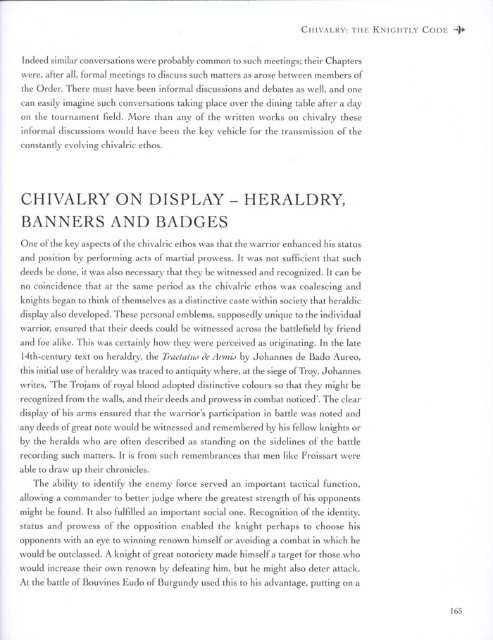Osprey - General Military - Knight - The Warrior and ... - Brego-weard
Osprey - General Military - Knight - The Warrior and ... - Brego-weard
Osprey - General Military - Knight - The Warrior and ... - Brego-weard
You also want an ePaper? Increase the reach of your titles
YUMPU automatically turns print PDFs into web optimized ePapers that Google loves.
Indeed similar conversations were probably common to such meetings; their Chapters<br />
were, after all, formal meetings to discuss such matters as arose between members of<br />
the Order. <strong>The</strong>re must have been informal discussions <strong>and</strong> debates as well, <strong>and</strong> one<br />
can easily imagine such conversations taking place over the dining table after a day<br />
on the tournament field. More than any of the written works on chivalry these<br />
informal discussions would have been the key vehicle for the transmission of the<br />
constantly evolving chivalric ethos.<br />
CHIVALRY ON DISPLAY - HERALDRY,<br />
BANNERS AND BADGES<br />
One of the key aspects ot the chivalric ethos was that the warrior enhanced his status<br />
<strong>and</strong> position by performing acts of martial prowess. It was not sufficient that such<br />
deeds be done, it was also necessary that they be witnessed <strong>and</strong> recognized. It can be<br />
no coincidence that at the same period as the chivalric ethos was coalescing <strong>and</strong><br />
knights began to think of themselves as a distinctive caste within society that heraldic<br />
display also developed. <strong>The</strong>se personal emblems, supposedly unique to the individual<br />
warrior, ensured that their deeds could be witnessed across the battlefield by friend<br />
<strong>and</strong> foe alike. This was certainly how they were perceived as originating. In the late<br />
14th -century text on heraldry, the Tract at ad de Armid by Johannes de Bado Aureo,<br />
this initial use of heraldry was traced to antiquity where, at the siege of Troy, Johannes<br />
writes, '<strong>The</strong> Trojans of royal blood adopted distinctive colours so that they might be<br />
recognized from the walls, <strong>and</strong> their deeds <strong>and</strong> prowess in combat noticed'. <strong>The</strong> clear<br />
display of his arms ensured that the warrior's participation in battle was noted <strong>and</strong><br />
any deeds of great note would be witnessed <strong>and</strong> remembered by his fellow knights or<br />
by the heralds who are often described as st<strong>and</strong>ing on the sidelines of the battle<br />
recording such matters. It is from such remembrances that men like Froissart were<br />
able to draw up their chronicles.<br />
<strong>The</strong> ability to identify the enemy force served an important tactical function,<br />
allowing a comm<strong>and</strong>er to better judge where the greatest strength of his opponents<br />
might be found. It also fulfilled an important social one. Recognition of the identity,<br />
status <strong>and</strong> prowess of the opposition enabled the knight perhaps to choose his<br />
opponents with an eye to winning renown himself or avoiding a combat in which he<br />
would be outclassed. A knight of great notoriety made himself a target for those who<br />
would increase their own renown by defeating him, but he might also deter attack.<br />
At the battle of Bouvines Eudo of Burgundy used this to his advantage, putting on a<br />
CHIVALRY: THE KNIGHTLY CODE -







